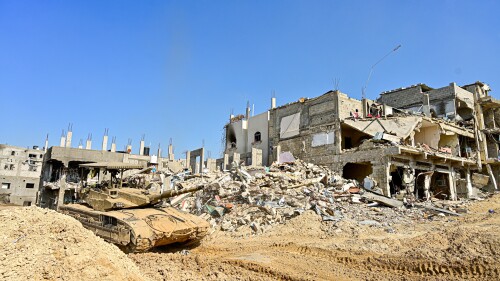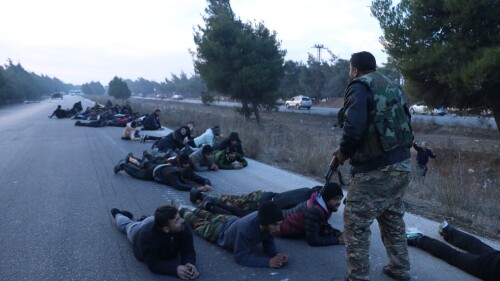[original National Post title: “An Ominous Silence: Armies at a stalemate as ISIS battles toward a Kurdish capital swollen with refugees”]
Kurdish peshmerga fighting to retake Mosul dam last month |
“Eighty years ago, they joined three nations together and formed Iraq. This mistake must not be repeated … The solution is a breakup,” says General Maghdid Haraki.
The Kurdish peshmerga officer is speaking from the front lines in Khazar, northern Iraq. His position is only 45 kilometres northwest of Erbil, capital of the autonomous Kurdish regional government (KRG), which along with Sunni and Shiite Arab lands makes up modern Iraq.
Today, not only the existence of Iraq is in jeopardy. So is the existence of the KRG itself, assailed by the Islamic State of Iraq & Al-Sham (ISIS), whose harsh brand of Islam is terrifying locals and appalling the world.
A single war between ISIS and the Kurds is now under way, stretching along an enormous front line from Jalawla, near the Iraq-Iran border, all the way to Jarabulus on the frontier between Syria and Turkey.
On the jihadi side of the line, the Iraqi-Syrian border no longer exists. ISIS now controls huge swaths of Syria and Iraq, and will continue to do so unless and until it is destroyed.
After their lightning advance from Mount Sinjar in early August, the jihadis have dug in on three sides of Erbil. Facing them are Gen. Haraki and the peshmerga.
The front lines are quiet for now, mainly because U.S. air strikes Aug. 8 stemmed the Islamists’ headlong rush toward the Kurdish capital. But the general and his men know the quiet is likely to be only transient.
To reach Erbil, ISIS forces would have to advance over bare, flat ground. Were they to attempt this, the Kurds would request the help of the Americans and the ISIS force would be obliterated. ISIS knows this, too. Hence the strange and sullen silence.
Nevertheless, Erbil remains tense. The city is swollen with refugees — Chaldean Christians from Mosul, Yezidis from the Sinjar area — who understand all too well what any jihadi advance would mean for them, non-Muslim minorities who were smart or lucky enough to get away in time.
They are living in tent encampments in open areas of Erbil and in the half-built grey structures that characterize this place, which had the feel of a boom town until fairly recently.
Now, the bars and restaurants catering for foreigners are largely empty. Employees of the big foreign oil firms and consular staff left hurriedly when the jihadis seemed to be about to descend. Many residents also fled.
ISIS has not forgotten Erbil. A terror campaign has begun here. There are mysterious explosions of a type familiar to residents of Iraqi cities further south. Last week, a car bomb ripped through a central neighbourhood, wounding several people.
But Kurdish forces are hunkering down, facing the jihadis with grim determination. With the help of U.S. air cover and Iraqi special fores, they are beginning to reconquer some of the areas lost. Most significantly, these include oilfields near Mosul, retaken this week, and the Mosul Dam, which provides water and electricity for much of northern Iraq.
The Kurds are well aware of what an ISIS victory would mean. After the jihadis took the Mount Sinjar area (Shinghal in Kurdish), they unleashed a series of atrocities that shocked even this most hardened of lands.
At the fly-blown Newroz refugee camp in northern Syria, Yezidi refugees described what happened when ISIS fighters appeared in their villages near the mountain and the peshmerga fled.
“We tried to withdraw all the women and kids from the village. People who could get to the mountains were safe, people who stayed were killed,” said Kawa, 30, who was lucky enough to escape with some of his family.
The refugees’ bitterness at their abandonment by the peshmerga remains raw and palpable. But still more tangible is the sense of stark horror as they recall the jihadis’ actions.
“When ISIS came to the village, they took all the women, and any man who could hold a weapon was slaughtered. Now they are selling Yezidi women for $5 in the slave market in Mosul,” Kawa says.
“My parents were too old and sick to come with us, and we had to leave them. We don’t know what has happened to them. Also, some people didn’t have fuel for their cars, and those ones couldn’t get to the mountain.”
The man and his family were among the lucky ones, rescued by members of the Kurdistan Workers’ Party (PKK), Turkish Kurds, who led them to safety in Syria.
The peshmerga’s failure to hold the line at Sinjar was a shock, both for observers and inhabitants of Kurdish northern Iraq. Gen. Haraki blames it on the help afforded ISIS by local Sunni Arabs.
In this regard, at least, he is in agreement with the refugees at Newroz.
“Our neighbours in Iraq became our enemies, and killed us,” says Kawa’s wife.
But the peshmerga’s initial failure was not only the product of local Sunni support for ISIS. These once-vaunted fighters had not taken part in combat for 20 years. Deprived of modern equipment by the Shiite-dominated government in Baghdad and the West, which remains suspicious of Kurdish separatist ambitions, they found themselves outgunned and initially outfought by the jihadi blitzkrieg.
But, as the refugees’ testimony suggests, other Kurdish forces appeared at Mount Sinjar mountain — the ragged and formidable fighters of the Kurdish YPG (People’s Protection Units) militia from Syria and PKK guerrillas from Turkey.
Armed only with Kalashnikovs and light machine guns, but with much combat experience, these fighters succeeded in opening a road from Sinjar up to Jezza, Rumeilan and then to the refugee camp outside Derik. Tens of thousands of lives may have been saved because of this action.
The YPG and ISIS are old acquaintances. The Kurds have been battling the jihadis since late 2012 to maintain two Kurdish-controlled enclaves on the border between Syria and Turkey, Jazeera and Kobani.
ISIS has been notably unsuccessful in its efforts to make progress in this little-reported front of the Syrian war.
The opening of the corridor from Mount Sinjar was the most notable achievement yet for the YPG/PKK.
It indicates that, for all their undoubted fanaticism, the jihadis are not invincible and can be turned back when met by equal commitment and greater skill.
On the Kurdish side, the peshmerga and the YPG, and their very different political masters are for now allied in the face of the common threat. They sense both threat and opportunity in the break-up of Syria and Iraq.
The threat can be seen 45 km outside of the KRG capital, in the silent but glowering positions of the Islamic State.
The opportunity, meanwhile, is that Kurdish sovereignty has already emerged as a more benign successor entity in a contiguous line across the old border — and Kurdish forces are today the only ones engaged in earnest against a savage force universally acknowledged to constitute an enemy of humanity.
Gen. Haraki’s statement that the break-up of Iraq represents the solution may well be heard more widely and insistently in the months ahead. This is a war to create new borders, and to hold back the advance of a savagery not seen in the Middle East for a generation.
Jonathan Spyer, a fellow at the Middle East Forum, is a Jerusalem-based journalist and researcher.








